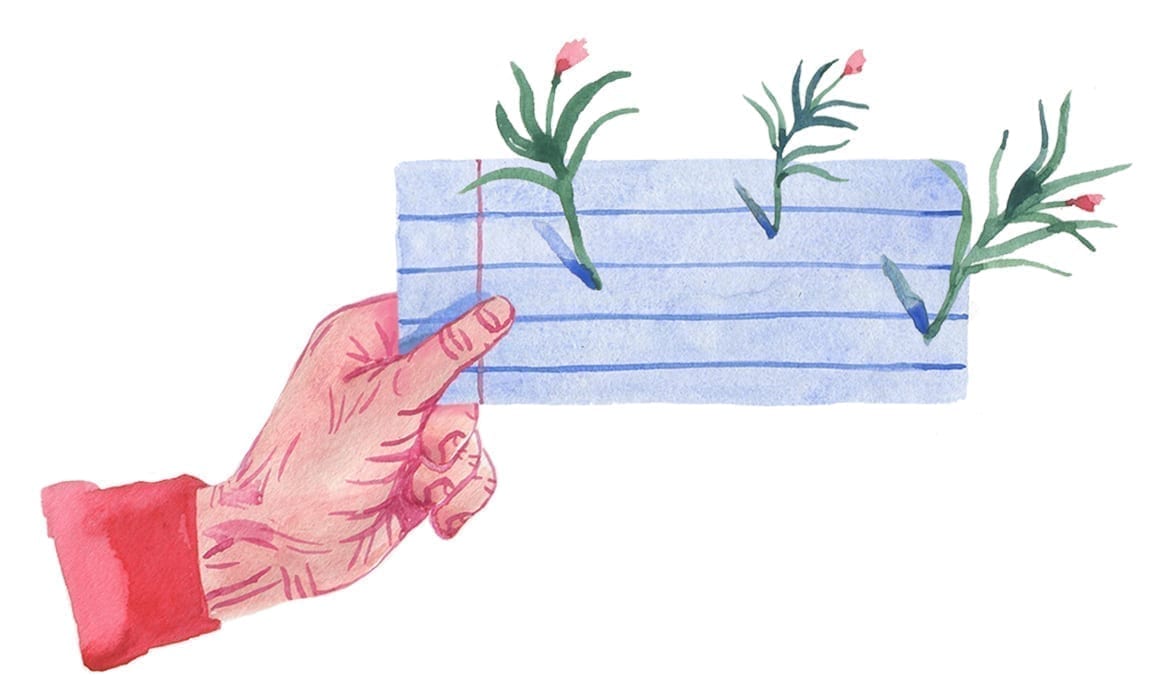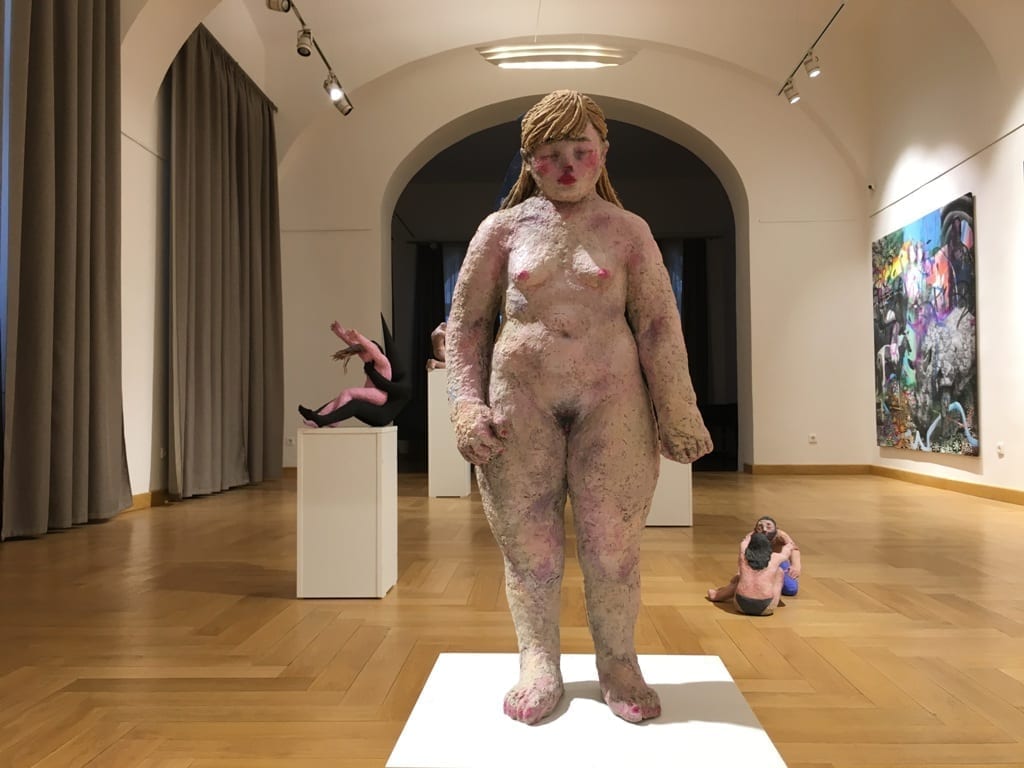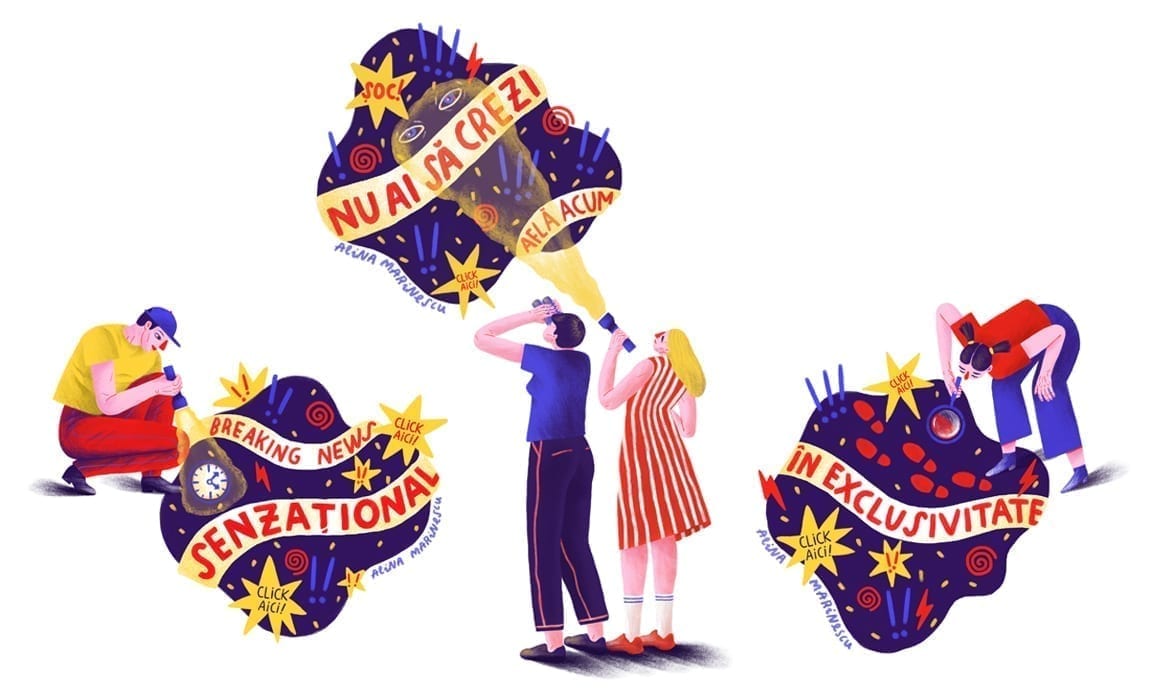How would Bucharest look like in a book illustration, with love statements and the inevitable dislikes? To what extent do people contribute to the charm of a city? What memories do we take with us from school and how do future creative people form thanks to the support of great teachers? We discussed all these ideas with Alina Marinescu, who spoke openly about being sincere in art, about love as a mix of states and an illustration subject, about her past exhibitions and future projects. Also, if you meet Alina during your walk in the capital, don’t be shy to greet her and continue the story of the Un-hidden Bucharest interview.
f: Hi, Alina, we were reading the work you published in January for Școala9. Tell us about the collaboration and what it meant for you to go back in time to the teachers who inspired you in choosing your current artistic path, respectively to expose the limitations of the education system. What are the main aspects that you would implement in the educational environment for those who want to pursue their artistic vocation? Do we still need marks, what would be the ideal class structure, etc.?
Alina Marinescu: For me, high school was one of the most beautiful times in my life. I remember the first day of school in the ninth grade, I looked around, and I couldn’t believe that all the people looked so cool and different and I had one of those moments when I knew for sure that I was where I should be. I always liked to draw, and although it was more of a chance to go to a vocational high school, I felt I had come to the place I had always wanted. Like when you first fall in love and everything appears to make sense, and finally your eyes were opened.

It was like giving you new glasses to see the world, but they have been yours forever.
Until high school, I couldn’t wait for the one-hour drawing I had weekly, and to suddenly have so many “mandatory” drawing classes seemed a dream. Even though some Arts teachers were not the most inspirational people, and many gave you the impression that they were teachers by need, not passion, I still felt I was learning something new, and I liked it.
When Oana from Școala9 [School9] invited me to talk about teachers, I did not seem to remember much about school. However, I realised that I can very easily remember the people who passed on good things that have stayed with me and which I still apply in my work now.

You have to continue writing, either you write nice or ugly. – Romanian Teacher

You have to wake up, you have a horse underneath you that can lift you. – Graphics Teacher
Regarding the aspects that I would implement in the educational environment, I believe everything starts with the people so I would invest in teachers. It would be great if all those cool teachers that some of us had the chance to meet wouldn’t be just exceptions.
Perhaps many capable people who could be excellent teachers and change lives choose to do something else because of the low wages in education. For example, I haven’t heard of doctors who became doctors because they’ve failed at something else in life. Physicians come to practice after an extended period of training and have salaries that motivate them to do their job as well as possible. Wouldn’t it be normal for teachers to have the same opportunity?

f: In one of the materials we were referring to previously, you said, “Since I started school, I think the thing that bewildered me the most was the way the mistake was looked at and how it came to define you.” In your view, can there be mistakes in art? Have you ever felt you did something “wrong” as an artist?
Alina Marinescu:
I understood quite late that it is OK to make mistakes so you can evolve. Probably all you have to do is try to be professional, that is, to do things as well as you can, even if you don’t always succeed. I think it’s good to be honest with yourself, to be lucid, but not to judge yourself too harshly, to understand yourself, to become aware of your mistakes and keep the good parts.
I think mistakes exist everywhere, and in art it’s a little more personal, that is, the one who creates art is best able to point out the mistake (provided he/she is sincere), because he/she is the only one who knows what was the purpose of the work and if it came out as it should.
I think I made a mistake when I didn’t do the best I could because I thought no one would notice that I didn’t do my best. It’s incredibly easy to become accustomed to cheating, but it’s a disservice to yourself because what you do represents you, not someone else.

f: Art is for you an instrument of self-knowledge. At the same time, from the viewer’s perspective, when we intersect with your works, we have the feeling that we’re in front of an open journal. Tell us about this exchange of energy and experiences that happens first in the work process, between the creator and creation, then between the work and the public. How do you feel when you create, how do you feel when others enter your artistic universe?
Alina Marinescu: I feel fortunate to be able to express myself visually. For me, it’s also a kind of therapy. I try to not think of the public and the fact that I have to show what I do because that would inhibit me and I would consider how to explain my work for all to understand and probably the result would be quite the opposite.
The simplest and safest way comes from inside, that is, I try to understand what is going on there, why I have certain states and how I can translate them so that I can understand myself better. Surprisingly, this way I can be more explicit for others because many people find themselves in those situations too. It is liberating for me to be able to show what I’m doing because that’s how communication is taken further. It is more enjoyable and more constructive to talk to people than to talk alone.
f: The relationships you have with people inspire you, and you express this through illustration, object and more. What was the most intense relationship you explored artistically?
Alina Marinescu: I believe it’s love, because it is always changing, goes in several directions and helps me learn something different every time, about the world and myself.
f: Among your last exhibitions that we visited was the one part of Amural [A4], where you approached the subject of intimate relationships. How has the theme of love evolved in your work, from the happy couple relationship to the woman’s objectification by her partner? If you were to illustrate love at this moment, what would you associate it with?
Alina Marinescu: The papier-mâché objects exhibited at the Multicultural Centre of Transylvania University in Brașov, within the 4th edition of Amural festival, are part of the project “From Love – Moral Facts”, my first personal exhibition. The project was exhibited in 2016 at Victoria Art Center in Bucharest, curator Ioana Ciocan, architect Attila Kim.
The works are fragments inspired by my personal experiences and do not have a predetermined order; together they form a kind of inventory and can be arranged after another narrative thread each time to tell different stories.
If I had to illustrate love at this time, I think I would fit it best in my sketchbooks, because I have nothing concrete to say, at the moment it’s more of a mix of states – nostalgia, gratitude, impatience, enthusiasm.

f: Since we’re discussing exhibitions, what are you working on now? What projects and/or new exhibitions will we see in 2019?
Alina Marinescu: I’m currently focusing on client work. However, this year I also want to concentrate on personal projects and I’ll try to squeeze them among the projects I receive from clients. I have many plans, and I hope that I will be able to finish half of them this year. At least one of them will be inspired by the relationships with people around me, family, friends etc., one I think goes towards poetry, another is about time and people. Soon I will also launch my website where I would like to sell personalised items with my illustrations. I didn’t plan exhibitions, but they usually appear along the way, and I announce them on Facebook and Instagram when they happen.

f: Of the illustration projects, we saw that you drew “with great pleasure” the volume “Și animalele sunt oameni! poezii pentru copii între 3 și 103 ani”[Animals are people too! poems for children between 3 and 103 years old], by Alexandru Mușina, re-edited by “George Barițiu” County Library Brașov and co-financed by AFCN. What do you love most about book illustration? Which book or types of books would you like to illustrate?
Alina Marinescu: I think that what I like most about book illustration is that there’s already a starting point, the text. Moreover, I want the text to challenge me in some way, to be able to find correspondence between myself and the text, to enrich it, to take it further. When I start personal projects, it’s harder to decide on the subject, because the possibilities are infinite.
I think it’s more challenging to find a way to manifest freely into an imposed space, that is, to be “limited” by the text in the case of book illustration. In this way, freedom becomes more valuable because you have to win it; it doesn’t come by default. I could illustrate fiction, poetry or any text that makes me feel something.

f: If Bucharest were a book you were invited to illustrate, how would an illustration from this book look like?
Alina Marinescu:
I love Bucharest with all its ugly parts, probably because I associate it with certain periods of my life and I attach myself easily and irremediably to places. So if I were to illustrate a book about Bucharest, I would like to write the text myself, to make love statements, and to tell the city what bothers me about it, when it happens.
I think it would be a book object, with mixed techniques, collages and pop-ups to get in your eyes, but you can’t mind too much because it also softens your heart. Like Bucharest.
f: Have you ever thought about “illustrating” the walls of Bucharest or taking your sculptural work outside? What theme would you choose, for instance, for a mural that we’d surely be happy to include in the Un-hidden Bucharest map? ♥
Alina Marinescu: My papier-mâché works are quite small, and they need an intimate space; the street would not be the most suitable place for them, mainly because the rain would melt them :)). However, I would like to create something new, specially designed for open space.
I would paint murals anytime, and if I had the opportunity to paint about Bucharest, I think it would be related to the city’s inhabitants, because I like people and they contribute a lot to the charm of the place.
f: We’d like to end our conversation with a message for the feeder.ro readers – what state/ words of wisdom/ food for thought/ question or experience do you want to share with them?
Alina Marinescu: I don’t know what else to add, but thanks for their patience if they’ve read to the end. And if we meet in Bucharest, come say hi. ♥

You can follow Alina on Instagram, Facebook and Behance.
This article is part of the Un-hidden Bucharest series of interviews with street art and graffiti artists, published weekly on feeder.ro. Together we will enter their artistic universe and learn how the city can be regenerated through artistic interventions in the public space.
Keep your eyes on feeder.ro, we’ll publish new interviews soon with iZZY iZVNE, Maria Bălan, John Dot S, Livi Po, J.Ace, Robert Obert, KSELEQOQYNQYSHY, Primitiv Print, Livia Fălcaru, Skinny Bunny, Maria Duda, Obie Platon, Irina Marinescu, Kero Zen, Lost.Optics, Serebe, CAGE, ILUC, Boeme1, Pisica Pătrată, Alexander Blot, and more.
Interview by Emilia Cazan
Images © Alina Marinescu & Orsolya Balint & Cătălin Georgescu & Save or Cancel
The Un-hidden Bucharest street art project is organized by Save or Cancel, through feeder.ro and is co-funded by AFCN. The program does not necessarily represent the position of the National Cultural Fund Administration. AFCN is not responsible for the content of the program or the way the program results can be used. These are entirely the responsibility of the beneficiary of the funding.
Organizer: The Save or Cancel team, composed of Cristina Popa (random) – social designer, editor, and cultural manager, and Andrei Racovițan (ubic) – architect, editor, and artistic manager, together with the audience, artists, collaborators și partners.
Project partners: CNDB, Faculty of Sociology and Social Work, Zeppelin, IQads, Igloo, Urban things, România Pozitivă, IQool
About Save or Cancel
Since 2008, Save or Cancel is a medium of communication and propagation of the arts and culture, promoting and facilitating their role in contemporary society.
The self-initiated multidisciplinary programs of Save or Cancel aim to identify sustainable and adaptable opportunities for (re) valorization of the existence through architectural, cultural and editorial projects.
Visit the project’s page to find out more about past, current and future activities: https://feeder.ro/un-hidden





































Pingback: Female power in local street art • feeder.ro
Pingback: Interview with Tobias Barenthin Lindblad (SE) – Un-hidden Bucharest [en] • feeder.ro
Pingback: Education discount for the Un-hidden Street Art in Romania book & more • feeder.ro
Pingback: Buy the Un-hidden Street Art in Romania BOOK with a 20% discount • feeder.ro
Pingback: The Un-hidden Street Art in Romania BOOK is now available in the feeder.ro/shop
Pingback: Un-hidden street art in Romania BOOK (preview)
Pingback: Discover a new Un-hidden Romania 🇷🇴 interview with Japanese 🇯🇵 artist Aito Kitazaki [video] • Feeder.ro